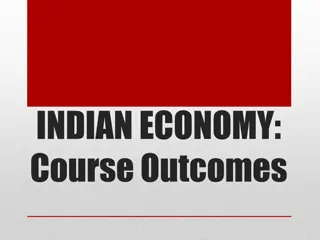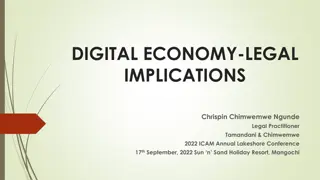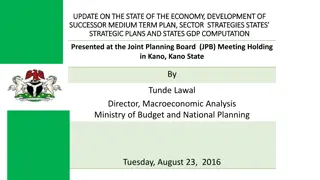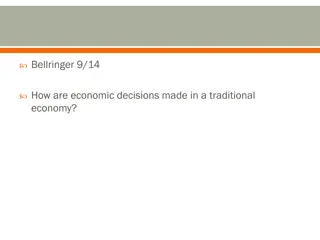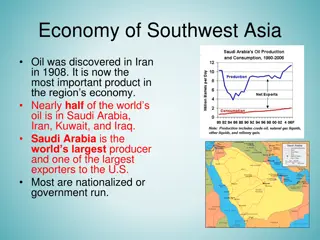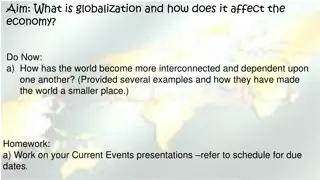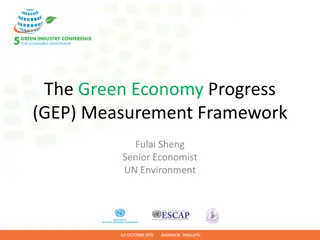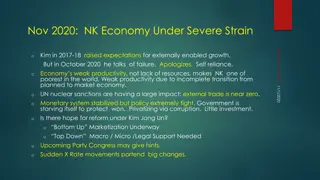The State of the US Economy: A Comprehensive Analysis
The US economy has shown signs of strength with significant GDP growth, job creation, and income improvements. However, challenges exist in long-term trends such as stagnant real median family income and rising income inequality. The decline in manufacturing jobs raises concerns about sectoral job losses and the impact of international trade. Despite productivity gains, certain job sectors face irrecoverable losses. The complex economic landscape demands a nuanced approach to policy-making and future planning.
Uploaded on Sep 16, 2024 | 0 Views
Download Presentation

Please find below an Image/Link to download the presentation.
The content on the website is provided AS IS for your information and personal use only. It may not be sold, licensed, or shared on other websites without obtaining consent from the author. Download presentation by click this link. If you encounter any issues during the download, it is possible that the publisher has removed the file from their server.
E N D
Presentation Transcript
An Economy That Works for All Americans Jeffrey Frankel Harpel Professor of Capital Formation and Growth Harvard University Bipartisan Program for Newly Elected Members of Congress December 7, 2016 1
Current state of the economy The Fed will almost certainly raise interest rates December 14. Why? The most recent stats are surprisingly strong: GDP growth in 3rd Quarter: 3.2 % or more. Employment: November continued the longest streak of total job growth on record: 15.6 million jobs added since early 2010. Unemployment rate down to 4.6%, considered full employment. Average hourly earnings: rose 2.7 % so far this year. And, for once, recent gains were widely shared: Median real family income: rose 5.2% in 2015, the fastest ever. Poverty rate: down to 13.5% from 14.8% in 2014, the largest drop since 1968. 2
The economy has added 15 million jobs since early 2010. 3
But the longer-term trend is not good: Real median family income is still below 2000! | | | 2007 2000 2015 4
The share of US income going to the top has risen since 1980, and is now back to the 1920s. 5 Chad Stone et al, CBPP, Sept 30, 2016 www.cbpp.org/research/poverty-and-inequality/a-guide-to-statistics-on-historical-trends-in-income-inequality
Manufacturing jobs -- 32% of the national total in 1950 -- had declined to 10% by 2010. Percent of employment in US manufacturing (1970-2012) 6
Long-term job loss in some sectors Manufacturing employment has been falling as a share since 1950, conspicuously in such sectors as autos, steel, and apparel though leaving viable competitive cores today. Is job loss due to international trade? Yes, in part, in some sectors. But trade has also created lots of other jobs. Also,manufacturing output continues to rise, even as employment falls. That means productivity has gone up a lot: It takes fewer workers to produce one auto today than 65 years ago, not to mention that the cars are much higher-quality. Those jobs are not coming back. By analogy, farmers were 90% of national employment in 1790 vs. 2% today. Or consider coal miners.
As with factory workers and farmers, we are not going back to the number of coal miners that were employed in 1923. 8 By Plazak - Own work, CC BY-SA 4.0, https://commons.wikimedia.org/w/index.php?curid=48261916
Some reasons for employment shifts Trade?It works in favor of the US agricultural and coal sectors. Even regulation has not been the big source of job loss in coal. Rather, in recent years, it has been cheap natural gas from fracking; and, before that, the shift from Appalachian underground mining to open-pit mining. In the case of all 3 sectors, the biggest reason for the decline in jobs has not been trade, but rather productivity growth, arising particularly from technological progress. The demand for labor has shifted toward high-skill jobs. Meanwhile the supply of high-skilled workers has not kept up: education gains have lagged since 1981. But regardless the causes of rising inequality, good policies can share income gains more widely. 9
Six policy proposals to promote An Economy That Works for All Americans 1. Increase infrastructure spending. 2. Move toward universal pre-school education. 3. Continue to raise the number of Americans with health insurance. 4. 5. Address the long-term rise in household debt. Reform the tax system Corporate income tax stay revenue-neutral: lower rate, but cut distorting deductions Reform personal income tax. Expand EITC Abolish the carried interest deduction. Institute the Cadillac tax on unnecessarily expensive health plans. Don t eliminate the estate tax. 6. Retain US global economic leadership including abiding by trade agreements. 10
An Economy That Works for All Americans Jeffrey Frankel Harpel Professor of Capital Formation and Growth Harvard University 11
Appendices 1. Addressing the long-term rise in household debt (i) Housing debt; (ii) Auto debt; (iii) Student loans. 2. List of causes of rising US inequality 3. More graphs illustrating macroeconomic developments 2009 turnaround from recession Budget deficit Trade deficit Some sources of inequality 12
Appendix 1: Address the long-term rise in household debt: housing, auto, & student loans (i) Reduce the policy tilt toward getting American families up to their eyeballs in mortgage debt they can t afford. It led to 2007-09 financial crisis. And it drives up housing prices, without even much raising home ownership rates. Specific policies: Require a serious minimum down payment, as other countries do. Require skin in the game, on the part of mortgage-originators. Curtail tax deductibility of mortgage interest, which mainly benefits the well-off. It generally saves less than $200 for households earning $65,000. Reduce deductions at the upper end, especially if loan is used for something other than purchase of residence i.e., 2ndhome or cash out for spending. Don t repeat the mistake of Fannie Mae and Freddie Mac 13
Address household debt: housing, auto & student loans, continued (ii) Auto dealers should not have been exempted from the Consumer Finance Protection Bureau. A rising share of sub-prime auto loans are now delinquent. (iii) Although most college educations are a good deal, and worth going into debt for if that is the only way, some enterprises are bad deals. Especially some for-profit universities. Government should expand student grants & loans, but require that the school have a decent record regarding rates of graduation & employment. 14
Appendix 2: Why has inequality risen in the US? 1. Trade probably does play a role, alongside other factors: 2. technological change raising demand for skilled workers, 3. outpacing education that raises the supply; 4. winner-take-all labor markets, 5. assortative mating, 6. reduced corporate competition & higher rents, 7. excessive executive compensation. 8. Piketty: wealth accumulates faster than income. 9. Possibly the decline in union power & minimum wages. 15
Appendix 3: More on macroeconomic developments The economy turned around in June 2009, but the recovery was slow and long. 16 https://www.whitehouse.gov/blog/2016/10/28/advance-estimate-gross-domestic-product-third-quarter-2016
Employment growth has been steady since early 2010. The private sector has added 15 million jobs in the last 81 months. 17
Consumer confidence is high, seeming to refute the notion that the official statistics fail to capture what ordinary people feel. 18
Widening gap between skilled & unskilled workers, defined by college graduation. 21 Jason Furman, CEA, Oct. 17, 2016, Fig.10.
The trend in years of education slowed during 1981-2012, so the supply of skilled workers has not kept up with the demand. Average Years of Schooling at Age 30, U.S. Native-Born, by Year of Birth, 1876-1982 Trend Trend 1906 1981 = 1876+30 to 1951+30. 1981 2012 = 1951+30 to 1982+30. 22 Jason Furman, CEA, Oct. 17, 2016, Fig.11.
The share of US national income going to labor has declined since 2000. Jason Furman, CEA, Oct. 17, 2016, Fig.13.
Manufacturing output rises even as employment falls, showing productivity growth. 24 What role for the workers in Trump s American factory revival? Financial Times, Nov. 23, 2016.




